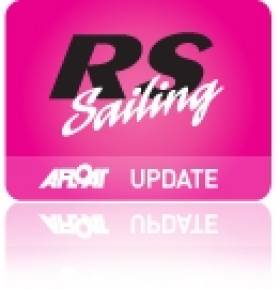Displaying items by tag: Emmet Ryan
RS200/400 Demo at Royal St George Next Weekend
#RS SAILING - UK RS Association chairman Pete Vincent will be running another RS200 and 400 demo day from the Royal St George Yacht Club on the weekend of 24-25 March.
The well-known expert on RS boats is being brought to Dublin by RS400 owners Richard Tate and Emmet Ryan, who are "really keen to get an RS fleet up and running" in Dun Laoghaire.
"After the huge attention our boats have drawn both ashore and on the water, we feel there is already a keen interest from a broad cross section of sailors to learn something more about these incredible hiking dinghies," says Tate.
"There is a ready-to-race format for both RS200s and 400s to have a full season of racing every Tuesday and Thursday in Dublin Bay right from the go."
The RS200 is described as a "natural progression" from the RS Feva, while the RS400 "takes the concept one step further and way beyond". Both classes provide high performance assymmetrical racing for all age groups.
If you are thinking about moving into an RS200 or 400, this is the perfect opportunity to help you make your decision.
All demo sails must be booked in advance by contacting Pete Vincent directly at +44 7812 899 043 or [email protected].
Match Racing Tour Title Up for Grabs in Kinsale
With Team Lazarus already having used their allocation of 7 sailors for the year and Andrew Fowler prioritizing preparation and qualification for the World Team Racing Championships, to be held in Shull next year, the door is open for John Sheehy and the Royal St George Yacht Club team to sneak through and take the Match Racing Tour title for a second year. A 5th place would leave the teams tied and with the last showdown between the two going to Lazarus the St George team -- rebadged Jodapama Racing for the nationals – need a 4th or better for Marty O'Leary to make it three in a row (Marty also crewed for Nicholas O'Leary in his 2008 championship win).
Shull team racing connections extend beyond the Lazarus absence.Darragh O'Connor is back on the main sheet with Jodapama, Billy Clarke takes to the bow for Casesy Elmes Racing and the boss man him self David Harty lines out for North Sails Ireland. Both Darragh and Billy where on the University of Limerick team that won and finished top Irish team at the IUSA team racing championships in 2009 and 2010. David should be an able stand in for John Downeys as the tours most vociferous questioner of umpiring decisions.
With the championships in Kinsale it's only right that there is a heavy KYC connection for many of the teams. Another graduate from the college ranks, UCD this time, Aiden McLaverty skippers Team ASM-Marine. Exile Same Hunt benefits from the contentious switch of Richie Murphy from Mad Match Racing. Together with Paddy Blaney and Peter Bayly to two make up a Gladiators team that looks extremely strong on paper. Last but not least George Kingston, John Curtan, Ben Scallan and Simon Rattigan take on the mantle of local heros.
5 point on the Tour and just 20 on ISAF ranking separate the final 2 teams. For North Sails Ireland Prof (who's brother Aiden makes up the final element of the Casey Elmes team) and Harty are joined by Barry and Teddy Byrne. Mad Match Racing field an all Howth Yacht Club line-up of Ben Duncan, Ric Morris, Joe Turner and Emmet Ryan.
The first round robin kicks off at 10am on Saturday under the able guidance of Alan Crosbie and chief umpire Mike O'Connor. With fresh weather forecast racing in the outer harbor should be hectic to say the least.
Racing during the day can be followed via the live feed on the matchracing.ie web site with coverage brought to you by Andy Deakin and Cube Images Brian Carlin.

























































